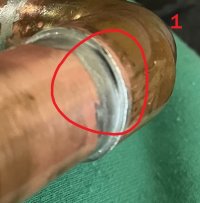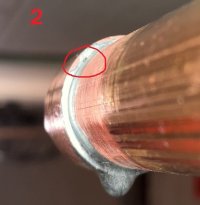Hello - I am a DIYer working on improving my solder skills and ran into an issue yesterday. When I was working on these, the solder seemed to have good "flow," I used the proper amount (3/4" per joint), and it generally felt good as it went into the joint, but I appear to have two tiny voids in the joints.
In the pictures, #1 looks worse than #2. However, if I tilt #1 the right way under bright light (hard to capture with my camera), it appears that #1 is sealed up just a few millimeters in from the lip of the fitting so it may well not leak. I can't really see into void #2 so I don't really know what to expect from that one, but #2 might actually be a little more concerning even though it is harder to see in the picture.
These may not end up leaking, but, any way to avoid this particular issue in the future? I wonder if maybe the pipes or fittings were not perfectly round?
Should I try to re-heat these and fix them, or start over?
I used Oatey H20 water soluable flux on these. I like to use the tinning flux but I realized the Oatey tinning flux I have is petrolatum based and I would prefer water soluble for my project because I am doing a decently long run of pipe straight to the cold water tap in my kitchen (replacing some very old galvanized pipe) and I don't want petrolatum-based flux to sit in my drinking water pipe for decades.
I have an order being shipped for the Oatey water soluble tinning flux which should arrive tomorrow, hopefully that helps a little bit.
In the pictures, #1 looks worse than #2. However, if I tilt #1 the right way under bright light (hard to capture with my camera), it appears that #1 is sealed up just a few millimeters in from the lip of the fitting so it may well not leak. I can't really see into void #2 so I don't really know what to expect from that one, but #2 might actually be a little more concerning even though it is harder to see in the picture.
These may not end up leaking, but, any way to avoid this particular issue in the future? I wonder if maybe the pipes or fittings were not perfectly round?
Should I try to re-heat these and fix them, or start over?
I used Oatey H20 water soluable flux on these. I like to use the tinning flux but I realized the Oatey tinning flux I have is petrolatum based and I would prefer water soluble for my project because I am doing a decently long run of pipe straight to the cold water tap in my kitchen (replacing some very old galvanized pipe) and I don't want petrolatum-based flux to sit in my drinking water pipe for decades.
I have an order being shipped for the Oatey water soluble tinning flux which should arrive tomorrow, hopefully that helps a little bit.
Attachments
Last edited:


